
| October, 2002 |
|
Event Review-The Age of Accessibility - Freedom & the Interaction of Movement
The theory of Universal Design is one in which the fundamental approach to design is inclusive, one that allows the freedom and interaction of physical, mental, and intellectual movement free of barriers. Thus, the environment becomes as usable as possible by as many people as possible, regardless of age, ability, or situation. But to create such a design, just like creating the foundations of any great movement, there are principles that must be considered and determined.
There are seven main principles to universal design: equitable use; flexibility in use; simple and intuitive; perceptible information; tolerance for error; low physical effort; and size and space for approach and use. When these principles are followed with a creative vision and an open approach to change, the outcome is that of an environment that allows all users the freedom of growth in a place designed for the accessibility of all. This may sound similar to such ephemeral foundations as government and religion, and like them, by following just and fair principles, Universal Design ultimately provides a freedom that was formerly impossible. But this freedom is not a theoretical or philosophical one, this is a freedom built into the physical stone and mortar of an existence- it is a building that comes to represent the diversity of culture and humanity through its inclusiveness.
Here in Baltimore, one such building's architecture exemplifies grace, ingenuity, and the principles and practices of universal structural accessibility - it is The University of Maryland School of Law.
On a recent trip to the newly re-designed school, I was given a tour of the premises and some of the new additions to the building. From fully accessible classrooms (including ramps throughout the room and wheelchair accessible desks) to lightweight doors and ADA standard lockers, the school has taken it upon itself to ensure an accessible design that does not glaringly stand out but which rather becomes a part of the ease and grace of the school itself.
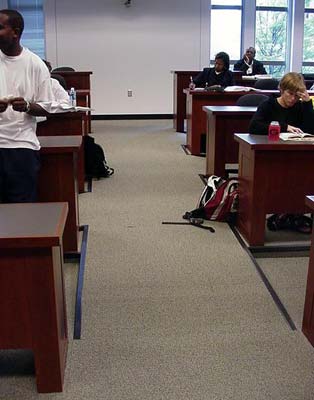 D.
D.
Ramps in the classrooms provide easy access to the entire room.
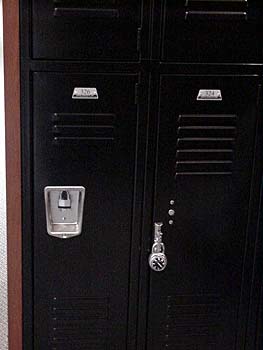 D. [ - art 5, pic 2]
D. [ - art 5, pic 2]
For every row of lockers at the University of Maryland Campus, there is at least one ADA compliant locker that makes it easier for a student with a disability to access.
The idea of accessibility in architecture that is fluid and simple is part of what drives the design of the new structure. Take, for example, the furniture in the building. It is not apparent that desks, tables, telephone booths, and more are accessible to those with disabilities; all too often we see those garish blue stickers of a person in a wheelchair stuck all over furniture and doors. The Maryland School of Law wanted the accessibility of its building and its furniture to blend with its design, to just be. Evidence of this lies in the design and layout of such simple things as the locker hallways (which provide sufficient wheelchair rotation movement) and library shelves that are not stacked to the top shelf (although someone with a mobility impairment would need to request the help of one of the librarians to remove books from the higher shelves). In fact, the library is perhaps one of the greatest examples of accessible ease, including a low library reference desk, accessible study tables, and accessible computer stations.
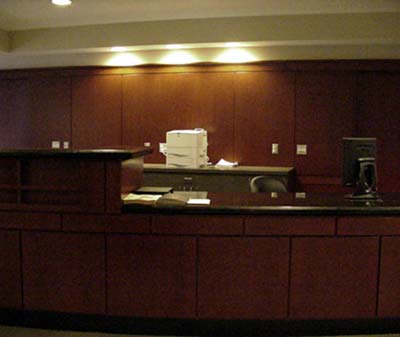 D.
D.
This multi-level reference desk makes it easy and comfortable for someone to approach the reference librarian with as few structural barriers as possible.
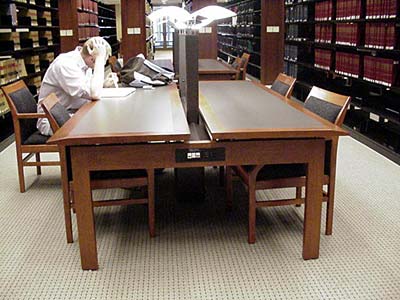 D.
D.
One of the study tables in the library that allows for easy access for someone using a wheelchair.
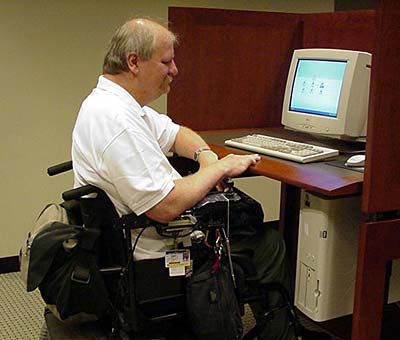 D.
D.
Paul Rasinski, Executive Director of MD TAP, sits at one of the computer stations (all of which are built for accessibility) in the Maryland Law Library.
The University of Maryland School of Law's dedication to the justice of individuals with disabilities through the idea of accessibility is testament to the schools constitutional, legal, and philosophical foundations of inclusion and equality for all people.
![]()
